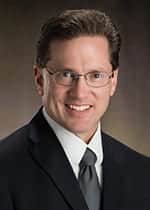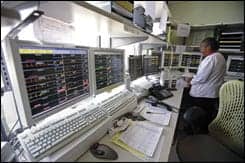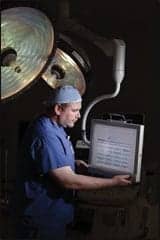Coming Together for Care
They say there’s strength in numbers—a phrase that certainly rings true in the case of Beaumont Health’s biomedical engineering department. 24×7 Magazine chief editor Keri Forsythe-Stephens sat down with five members of the sprawling clinical engineering team—John Fragomeni, CBET, CHFM, system vice president of support services; Daniel Zimba, senior director of biomedical/clinical engineering; lead technician Phil Sabo; biomedical engineer Matt Sikora, BMET; and biomedical engineer Geoffrey Smith, CBET—to learn what sets the Southeastern Michigan-based department apart. Don’t miss out.
24×7 Magazine: What are some key advantages your biomedical engineering department offers?
John Fragomeni and Daniel Zimba: One area that sets us apart is how well we work together as a collective team and support each other when and where needed. Our department is comprised of 53 biomedical engineering technicians, nine diagnostic imaging technicians, and three clinical engineers that support eight hospitals and various ancillary offsite locations in Southeast Michigan.
With a team this large, we can tap into our team’s wide variety of generalized and specialized skill sets. Our team members really demonstrate pride in our organization and are truly committed to doing the best they can to ensure that we provide our patients with safe and reliable equipment.
24×7 Magazine: How has the clinical engineering department evolved in the past few years? How do you expect the department to evolve even more in the future?
Fragomeni and Zimba: We have undergone many changes over the years. Beaumont Health was formed as a new organization in September 2014 through the merger of Beaumont Health System, Oakwood Healthcare, and Botsford Hospital. This has created significant opportunities regarding how we operate as a biomedical engineering department and a system.
Bringing best-in-class practices from each of the founding organizations into one system has been very challenging to say the least, but the outcome has created a better model moving forward for Beaumont Health. Our group has been focused on updating policies and procedures so they are consistent throughout the organization. For instance, we merged the data from three independent CMMS’ into one system, which has the architecture to accommodate the workflow of our organization. Our focus is on driving efficiencies while leveraging the size and scope of the organization’s medical equipment inventory.
Phil Sabo: As for the future of the biomed industry, we have seen some equipment manufacturers move more toward the service side of things, rather than just developing [products]. And we will continue to see manufacturers of medical equipment want to sell service contracts on their equipment.
As this happens, equipment manufacturers will need more biomeds to do the service. This, I think, will result in biomeds being more specialized, working on more specific types of equipment—rather than the vast array we typically have worked on in the past.
24×7: Please walk us through a typical day in the biomedical engineering department.
Matt Sikora: It can vary—which is to say that when it rains, it pours. Some days, our pagers go off nonstop and work orders come in faster than we can remove them. But there are also slower days, which gives us the chance to catch up on our paperwork and get a jump on our monthly PMs.
Geoffrey Smith: There is nothing ‘typical’ in our day. We can get up in the morning with the best plan of getting our work done, and the minute we walk in, the pager goes off. We have work orders needing immediate attention; we have administrative changes to our computers or password changes; and we are instantly turned into ‘firemen’ or ‘firewomen.’ We must put out fires and repair immediate issues—and at the end of our so-called ‘typical’ day, we wonder what happened since no scheduled work was able to be completed.
A typical day is either being the technician to carry the “Priority Pager” for all emergency repairs pages, the back-up technician to assist the priority repairs, the dialysis technician (if you are one of our factory-trained dialysis technicians), or concentrating on getting scheduled maintenance done. This would be typical; however, each one of us will try to assist with priority repairs and finish our scheduled work.
But throughout the day, [hospital] staff members walk into our department with requests, interrupting us. That is what makes this field exciting—as well as teeth-grinding at times—and makes us go bald at a young age. You never know what to expect when you walk in the door.
24×7: Can you please discuss a time when your department saved the day for another hospital department?
Fragomeni and Zimba: One example is when a patient telemetry central monitor goes down: When this occurs, there may be multiple critical cardiac patients whose ECG signals are no longer being monitored, thus creating a patient safety issue. Nursing management is immediately made aware of this, which can add even more stress to an already stressful situation because all eyes are on how long it takes to get everything back online.
Although a monitor may not show waveforms for many reasons, we can normally get everything back online in a minimal amount of time because we have a well-trained team to effectively troubleshoot.
The same scenario can be applied to almost any critical equipment or systems we maintain, such as anesthesia gas machines, imaging equipment, dialysis machines, ventilators, CPD sterilizers, etc. At one time, every one of our service line areas have had equipment in need of repair that impacted patient care or department operations.
We may not always think of ourselves as actually ‘saving the day’ because supporting clinical areas is just a normal part of our job. But we do feel satisfaction knowing that we were able to resolve a problem that helped our patient care staff in providing safe, high-quality care for our patients.
24×7: How does your employer support the continuing education/training endeavors of members of the biomedical engineering department?
Fragomeni and Zimba: A successful biomedical engineering department requires well-trained and competent staff. And that requires ongoing training and competency review. We have a structured program to annually review the needs of the organization and budget the necessary funding to provide the training needed for our staff. We also work with our vendors to provide staff with onsite in-services and new technology reviews. Cross-training provided by experienced and factory-trained technicians within our department and annual competency reviews are other methods we routinely use.
24×7: Anything else you want to tell 24×7 Magazine readers about the Beaumont Health biomedical engineering department?
Fragomeni and Zimba: We have a very diverse team boasting many years of experience—and we will always evolve as a department. One thing we can always count on is that nothing in our field stays the same. Over the years, our department has continually looked for ways to improve services and evaluate how we are getting things done. For example, last year we looked at how we were maintaining anesthesia gas machines, as we currently have more than 240 in our entire health system.
In the past, factory-trained, in-house BMETs completed the preventative maintenance and service at that specific hospital site, or we utilized a combination of vendor service contracts. However, we recently pooled our resources together to maintain these exclusively in-house by implementing PM teams that travel to the different locations, with the sole purpose of getting these machines done at times when they are most accessible and available.







